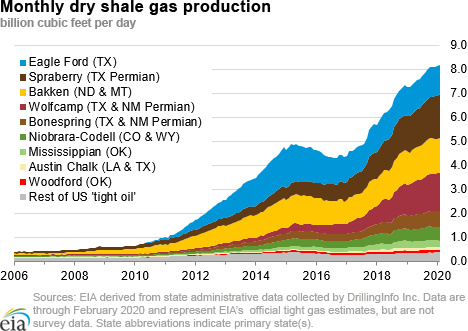In the News:
HGL prices collapse in 2020, revealing how pricing dynamics have changed since 2008
Spot prices of hydrocarbon gas liquids (HGLs), produced by both natural gas processors and petroleum refiners, have fallen rapidly since early March 2020. HGL prices now move within a narrow band along with crude oil and natural gas spot prices when measured at their heating values. This narrow price band among these fuels mirrors what occurred in the energy markets in 2008 following the financial collapse during the great recession.
Ethane and propane spot prices at Mt. Belvieu (measured in U.S. dollars per million British thermal units, $/MMBtu) fell 17% and 19%, respectively, from January to March 2020. This price drop was the result of market concerns about declining demand related to the 2019 novel coronavirus disease (COVID-19) combined with OPEC’s shift toward a market-share strategy following their meeting on March 6, 2020. The price of international crude oil fell about 46% in the same timeframe.
Despite lower prices, global demand for oil is expected to decrease because of the economic effects of COVID-19. This price drop is similar to what happened in 2008, when price declines occurred along with demand declines. In 2008, concerns about demand destruction related to the recession drove a decrease in ethane and propane prices of 74% and 68%, respectively, from July 2008 until the end of that year, while international crude oil prices fell about 69% during that same period.
The price spreads between ethane and propane and international crude oil from before and after the price collapses of 2008 and 2020 show how tightly ethane, and to a lesser extent propane, now track with natural gas compared with 2008. During the price collapse in 2008, the price spread between crude oil and natural gas narrowed by $11.92/MMBtu in July 2008 to $1.96 in December 2008. The price spread of ethane and propane to natural gas during the same timeframe in 2008 narrowed by $9.45/MMBtu and $7.21/MMBtu, respectively.
After the United States became a net exporter of HGLs in 2011, ethane, and to a lesser extent propane, became increasingly linked with domestic natural gas prices rather than international crude oil prices. This evolution coincided with increased production levels of wet (liquids-rich) natural gas plays and associated natural gas in oil-rich plays. Ethane and propane prices have had downward pressure as a result of growth in natural gas plant liquids (NGPL) production, which nearly doubled from 2010 to 2019. Currently, the price spread between crude oil and natural gas from January 2020 to March 2020 was a decrease of $4.87/MMBtu to $4.11/MMBtu in March 2020. The price spread between ethane and propane to natural gas, during the same timeframe, decreased by $0.15/MMBtu and $0.57/MMBtu, respectively.
Prices from the first week of April indicate that crude oil, natural gas, ethane, and propane prices are falling further.
Overview:
(For the week ending Wednesday, April 8, 2020)
- Natural gas spot prices rose at most locations this report week (Wednesday, April 1 to Wednesday, April 8). The Henry Hub spot price rose from $1.60 per million British thermal units (MMBtu) last Wednesday to $1.80/MMBtu yesterday.
- At the New York Mercantile Exchange (Nymex), the price of the May 2020 contract increased 20¢, from $1.587/MMBtu last Wednesday to $1.783/MMBtu yesterday. The price of the 12-month strip averaging May 2020 through April 2021 futures contracts climbed 13¢/MMBtu to $2.346/MMBtu.
- The net injection to working gas totaled 38 billion cubic feet (Bcf) for the week ending April 3. Working natural gas stocks total 2,024 Bcf, which is 76% more than the year-ago level and 19% more than the five-year (2015–19) average for this week.
- The natural gas plant liquids composite price at Mont Belvieu, Texas, rose by 3¢/MMBtu, averaging $2.52/MMBtu for the week ending April 8. The prices of isobutane and ethane fell by 2% and 5%, respectively. The price of natural gasoline remained flat week over week while the prices of propane and butane rose by 1% and 20%, respectively. Recently issued waivers allowing continued sales of winter-grade gasoline have enabled more butane blending, which increased butane prices.
- According to Baker Hughes, for the week ending Tuesday, March 31, the natural gas rig count decreased by 2 to 100. The number of oil-directed rigs fell by 62 to 562. The total rig count decreased by 64, and it now stands at 664.
Prices/Supply/Demand:
Prices rise at most locations. This report week (Wednesday, April 1 to Wednesday, April 8), the Henry Hub spot price rose 20¢ from $1.60/MMBtu last Wednesday to a high of $1.80/MMBtu yesterday. Temperatures were warmer than normal in the Northeast and Southeast and much cooler than normal across the central and western United States, particularly in the Great Plains. At the Chicago Citygate, the price increased 24¢ from $1.51/MMBtu last Wednesday to a high of $1.75/MMBtu yesterday.
California prices rise in response to weather. The price at PG&E Citygate in Northern California rose 19¢, up from $2.27/MMBtu last Wednesday to $2.46/MMBtu yesterday. The price at SoCal Citygate in Southern California increased 49¢ from $1.51/MMBtu last Wednesday to $2.00/MMBtu yesterday. Prices rose as weather drove increased natural gas consumption: colder-than-normal average temperatures increased demand for space heating, and above-normal precipitation levels decreased the output from solar resources, requiring increased natural gas-fired power generation.
Northeast prices rise. At the Algonquin Citygate, which serves Boston-area consumers, the price went up 15¢ from $1.49/MMBtu last Wednesday to a high of $1.64/MMBtu yesterday. At the Transcontinental Pipeline Zone 6 trading point for New York City, the price increased 9¢ from $1.38/MMBtu last Wednesday to $1.47/MMBtu yesterday.
The Tennessee Zone 4 Marcellus spot price increased 10¢ from $1.26/MMBtu last Wednesday to $1.36/MMBtu yesterday. The price at Dominion South in southwest Pennsylvania rose 17¢ from $1.27/MMBtu last Wednesday to $1.44/MMBtu yesterday.
Permian Basin prices end the week at a low. The price at the Waha Hub in West Texas, which is located near Permian Basin production activities, averaged $0.18/MMBtu last Wednesday, $1.42/MMBtu lower than the Henry Hub price. Yesterday, the price at the Waha Hub averaged a low of -$0.02/MMBtu, $1.82/MMBtu lower than the Henry Hub price. The Natural Gas Pipeline Co. of America declared a force majeure that went into effect yesterday—expected to remain through April 18—that has reduced flows through Station 105 in Cloud County, Kansas, approximately 130 miles northeast of Topeka, Kansas. Overall, the force majeure constrains 0.45 Bcf/d of capacity on the Amarillo mainline, according to Natural Gas Intelligence.
Supply is flat. According to data from IHS Markit, the average total supply of natural gas remained the same as in the previous report week, averaging 97.4 Bcf/d. Dry natural gas production remained unchanged week over week. Average net imports from Canada decreased by 2% from last week.
Demand falls, driven by lower demand for space heating. Total U.S. consumption of natural gas fell by 6% compared with the previous report week, according to data from IHS Markit. In the residential and commercial sectors, consumption declined by 15% amid seasonal spring temperatures. Natural gas consumed for power generation was flat, averaging 26.0 Bcf/d. Industrial sector consumption decreased by 5% week over week. Natural gas exports to Mexico decreased 10% as NET Mexico underwent annual maintenance from April 3–8 according to Genscape, which estimated flows declined by as much as 1 Bcf/d over that time period.
U.S. LNG exports decrease week over week. Twelve LNG vessels (five from Sabine Pass, two from each Corpus Christi, Cove Point, and Cameron, and one from Freeport) with a combined LNG-carrying capacity of 42 Bcf departed the United States between April 2, 2020, and April 8, 2020, according to shipping data provided by Marine Traffic. This number is the lowest reported weekly tanker count since the beginning of this year.
Storage:
The net injection into storage totaled 38 Bcf for the week ending April 3, compared with the five-year (2015–19) average net injection of 6 Bcf and last year's net injection of 25 Bcf during the same week. Working natural gas stocks totaled 2,024 Bcf, which is 324 Bcf more than the five-year average and 876 Bcf more than last year at this time.
According to The Desk survey of natural gas analysts, estimates of the weekly net change to working natural gas stocks ranged from a net injection of 9 Bcf to 37 Bcf, with a median estimate of 28 Bcf.
More storage data and analysis can be found on the Natural Gas Storage Dashboard and the Weekly Natural Gas Storage Report.
See also:
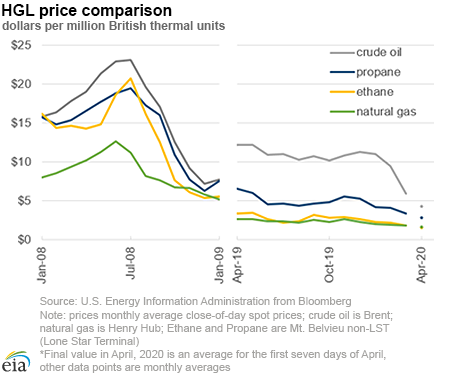
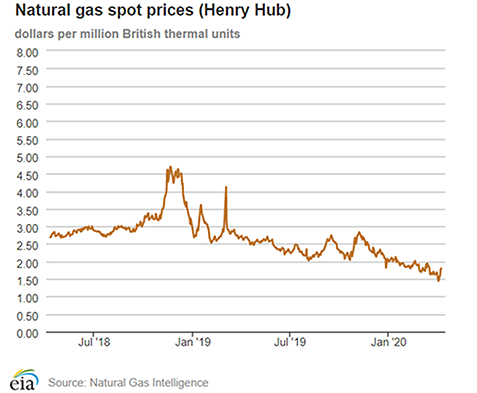
| Spot Prices ($/MMBtu) | Thu, 02-Apr |
Fri, 03-Apr |
Mon, 06-Apr |
Tue, 07-Apr |
Wed, 08-Apr |
|---|---|---|---|---|---|
| Henry Hub |
1.48 |
1.45 |
1.61 |
1.77 |
1.80 |
| New York |
1.32 |
1.35 |
1.40 |
1.48 |
1.47 |
| Chicago |
1.47 |
1.43 |
1.63 |
1.73 |
1.75 |
| Cal. Comp. Avg.* |
1.66 |
1.57 |
1.82 |
1.93 |
1.88 |
| Futures ($/MMBtu) | |||||
| May contract | 1.552 |
1.621 |
1.731 |
1.852 |
1.783 |
| June contract |
1.672 |
1.738 |
1.844 |
1.949 |
1.896 |
| *Avg. of NGI's reported prices for: Malin, PG&E Citygate, and Southern California Border Avg. | |||||
| Source: NGI's Daily Gas Price Index | |||||
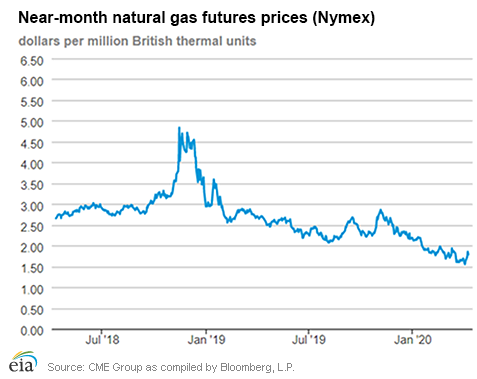
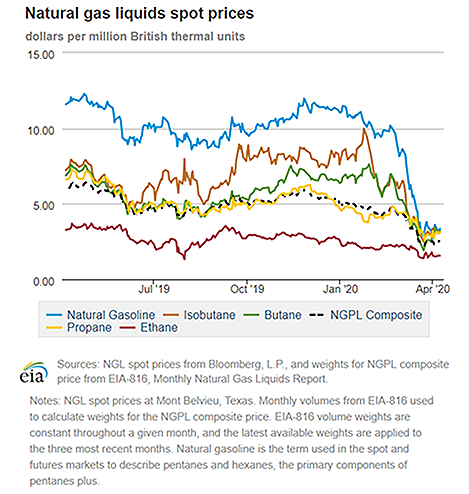
| U.S. natural gas supply - Gas Week: (4/2/20 - 4/8/20) | |||
|---|---|---|---|
Average daily values (Bcf/d): |
|||
this week |
last week |
last year |
|
| Marketed production | 105.9 |
106.1 |
100.5 |
| Dry production | 93.6 |
93.7 |
89.4 |
| Net Canada imports | 3.8 |
3.9 |
4.4 |
| LNG pipeline deliveries | 0.1 |
0.1 |
0.1 |
| Total supply | 97.4 |
97.7 |
93.9 |
|
Source: IHS Markit | |||
| U.S. natural gas consumption - Gas Week: (4/2/20 - 4/8/20) | |||
|---|---|---|---|
Average daily values (Bcf/d): |
|||
this week |
last week |
last year |
|
| U.S. consumption | 67.2 |
71.8 |
68.4 |
| Power | 26.0 |
26.1 |
25.2 |
| Industrial | 20.9 |
21.9 |
21.8 |
| Residential/commercial | 20.4 |
23.8 |
21.4 |
| Mexico exports | 4.9 |
5.5 |
4.8 |
| Pipeline fuel use/losses | 6.5 |
6.6 |
6.3 |
| LNG pipeline receipts | 8.6 |
9.6 |
3.4 |
| Total demand | 87.2 |
93.4 |
83.0 |
|
Source: IHS Markit | |||
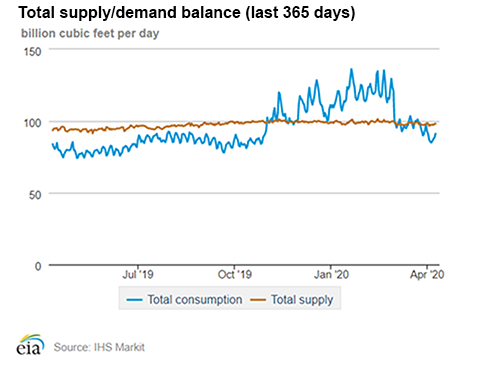
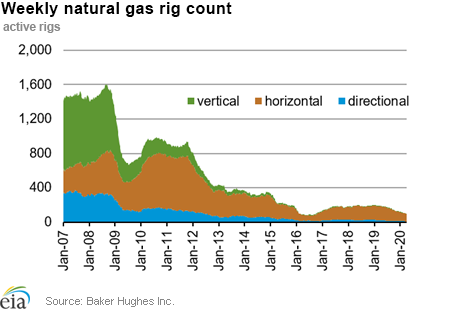
| Rigs | |||
|---|---|---|---|
Tue, March 31, 2020 |
Change from |
||
last week |
last year |
||
| Oil rigs | 562 |
-9.9% |
-32.4% |
| Natural gas rigs | 100 |
-2.0% |
-48.5% |
| Note: Excludes any miscellaneous rigs | |||
| Rig numbers by type | |||
|---|---|---|---|
Tue, March 31, 2020 |
Change from |
||
last week |
last year |
||
| Vertical | 0 |
0.0% |
0.0% |
| Horizontal | 7 |
-12.5% |
-68.2% |
| Directional | 41 |
-12.8% |
-41.4% |
| Source: Baker Hughes Inc. | |||
| Working gas in underground storage | ||||
|---|---|---|---|---|
Stocks billion cubic feet (Bcf) |
||||
| Region | 2020-04-03 |
2020-03-27 |
change |
|
| East | 382 |
382 |
0 |
|
| Midwest | 475 |
476 |
-1 |
|
| Mountain | 92 |
92 |
0 |
|
| Pacific | 203 |
197 |
6 |
|
| South Central | 872 |
840 |
32 |
|
| Total | 2,024 |
1,986 |
38 |
|
|
Source: Form EIA-912, Weekly Underground Natural Gas Storage Report | ||||
| Working gas in underground storage | |||||
|---|---|---|---|---|---|
Historical comparisons |
|||||
Year ago (4/3/19) |
5-year average (2015-2019) |
||||
| Region | Stocks (Bcf) |
% change |
Stocks (Bcf) |
% change |
|
| East | 209 |
82.8 |
274 |
39.4 |
|
| Midwest | 240 |
97.9 |
355 |
33.8 |
|
| Mountain | 64 |
43.8 |
111 |
-17.1 |
|
| Pacific | 117 |
73.5 |
209 |
-2.9 |
|
| South Central | 517 |
68.7 |
751 |
16.1 |
|
| Total | 1,148 |
76.3 |
1,700 |
19.1 |
|
| Source: Form EIA-912, Weekly Underground Natural Gas Storage Report | |||||
| Temperature – heating & cooling degree days (week ending Apr 02) | ||||||||
|---|---|---|---|---|---|---|---|---|
HDD deviation from: |
CDD deviation from: |
|||||||
| Region | HDD Current |
normal |
last year |
CDD Current |
normal |
last year |
||
| New England | 159 |
-11 |
11 |
0 |
0 |
0 |
||
| Middle Atlantic | 128 |
-26 |
-13 |
0 |
0 |
0 |
||
| E N Central | 126 |
-34 |
-36 |
0 |
0 |
0 |
||
| W N Central | 111 |
-44 |
-58 |
0 |
-1 |
0 |
||
| South Atlantic | 52 |
-32 |
-39 |
31 |
18 |
20 |
||
| E S Central | 47 |
-31 |
-44 |
16 |
11 |
16 |
||
| W S Central | 23 |
-20 |
-43 |
30 |
16 |
21 |
||
| Mountain | 152 |
14 |
22 |
1 |
-3 |
-2 |
||
| Pacific | 102 |
22 |
36 |
0 |
-2 |
0 |
||
| United States | 102 |
-18 |
-18 |
10 |
5 |
7 |
||
|
Note: HDD = heating degree day; CDD = cooling degree day Source: National Oceanic and Atmospheric Administration | ||||||||
Average temperature (°F)
7-day mean ending Apr 02, 2020
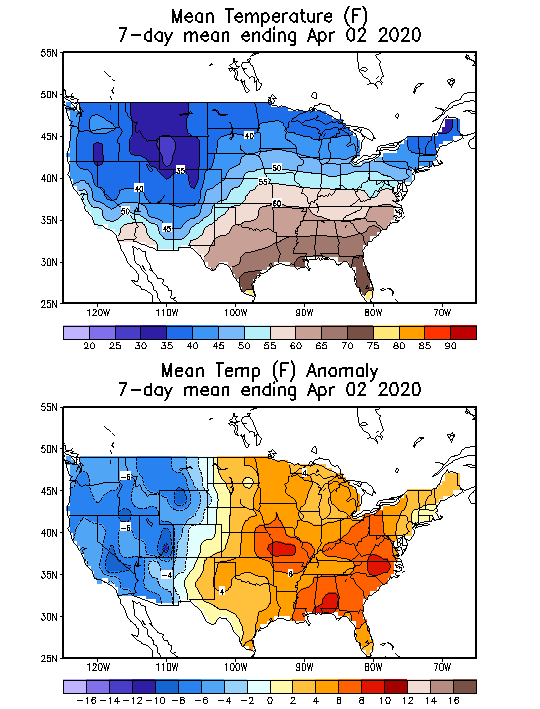
Source: National Oceanic and Atmospheric Administration
Deviation between average and normal (°F)
7-day mean ending Apr 02, 2020

Source: National Oceanic and Atmospheric Administration

